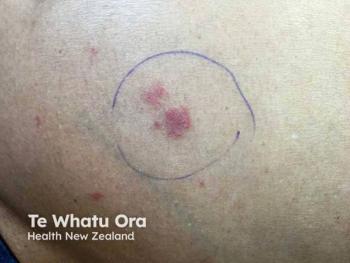
Case 2 Continued: Addressing Injectable Medications in Children
Joshua Zeichner, MD; Brittany Craiglow, MD; Elizabeth Swanson, MD; and Vikash Oza, MD, address techniques for injectables when treating pediatric patients with atopic dermatitis.
Episodes in this series

Joshua Zeichner, MD: How do you guys address the idea of taking a medication that’s given by an injection for a little child? For adults perhaps it’s an easier conversation, but it’s definitely a challenge when you’re dealing with children.
Vikash Oza, MD: I’m sure we all have different techniques. Most of the time, we’re doing the injection the first time in our office, so we try to go through some of the techniques, and obviously we’re teaching at the same time. For those of us in pediatrics, there are several things that we do. The first is distraction. My kids barely know when I’m home because they’re constantly being distracted by a screen, so the power of the screen is very important. It’s helpful to have them in a comfortable position and distracted, and then even held in a certain way. As an adult, you’re just used to them lying on the table and you inject it. But in kids, there’s what we call the comfort hold: being held in the parent’s arms, where they’re secured in certain ways and the limb is secured, but they’re also being held by a parent, which is comforting for a child.
There are also ways that we can reduce pain, such as a topical anesthetic, having EMLA [lidocaine, prilocaine] sitting there for an hour before you inject. Some children seem to do a little better with ice sometimes, too. Making that available and doing it in the office for the first time to show them is important. Some kids will even balance their own risks and benefits. They realize that the injection does hurt for that moment, but particularly those who have severe atopic dermatitis, if they’re in a certain age group, they’ll realize the impact that it’s having on them. When they see the improvements, you get buy-in sometimes that way as well.
Elizabeth Swanson, MD: To that point, I’ll often tell children, especially 5- to 8-year-olds who are old enough to understand: “Yes, the shot hurts. But that 3 seconds of ouch is worth feeling better every other second of every other day, so put up with it for this 2 or 3 seconds, and then you’re going to feel so much better the rest of the time.” In the younger kids, the 2- to 4-year-olds, when they start Dupixent, or dupilumab, I’ll often have them sit in their parent’s lap, facing their parent in a hug. Then we’ll give it either in the thigh or the arm, whatever is most accessible and easiest to do.
The biggest issue that I’ve noticed in starting to use the medication in younger patients, the 2- to 4-year-olds, isn’t the first shot or the second or third, but after that. They start to have anticipation. They know that the past 2 or 3 times they’ve come to this office, they got a shot. I’d be interested in whether other people on the panel are dealing with that, and how, because I find that has become a little harder. At that point, the parents have pretty much bought into the process because they’re seeing the impact that it’s having for their child, and they like that very much. But it gets a little harder with the children themselves, because they’re anticipating the ouch factor.
Brittany Craiglow, MD: I agree 100%. I like to try to get families to do it at home, because for the child, with the car ride, the waiting room, and the examination room, the anxiety is building. But a lot of parents don’t want to be the one to do it. I also completely understand that. I’ve recently started asking, “Is there anyone in your circle who might be able to do it?” One of my patients has his aunt doing it. For another one, their neighbor used to be a nurse. It doesn’t even have to be a medical person, just somebody who’s helpful because they’re a little more comfortable with it. Not the parent, but somebody else, so you can avoid all that buildup for this small thing.
Lisa, to your point, acknowledging that it hurts is important. We have this tendency, especially parents, to say: “Oh, it isn’t that bad. You’re OK.” But with kids with anxiety, it’s important to say, “Yes, this is uncomfortable, but you can handle it,” for those who are 6 years old and up. Making sure it’s room temperature is also important. I always tell the families take it out of the fridge the night before. Put the reminder in your phone and take it out the night before so that when you’re ready, you’re ready. That prevents everyone looking at it on the kitchen counter, counting down the hour. Dupilumab is fine at room temperature for 2 weeks, so if you don’t do it that day, you do it the next day. Work with them to figure out ways to make it easier. In some cases, it’s still going to be hard, but we can make it work for the majority of them.
Joshua Zeichner, MD: This is such an interesting discussion. There are so many social factors that we have to take into consideration. This is the art of medicine.
Transcript edited for clarity
Newsletter
Like what you’re reading? Subscribe to Dermatology Times for weekly updates on therapies, innovations, and real-world practice tips.
























